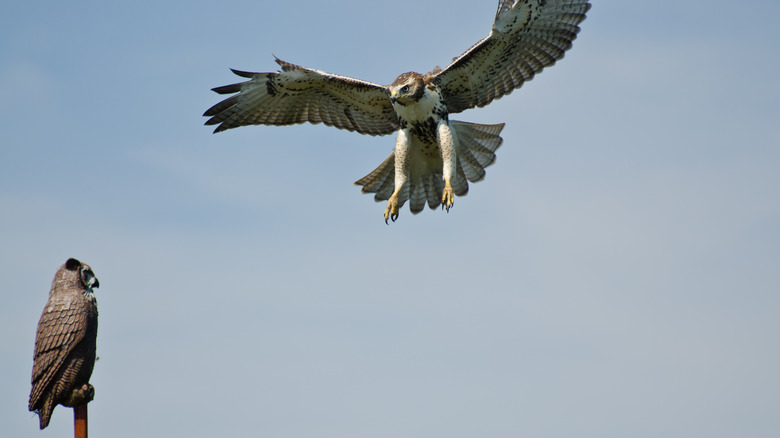Tips For Making Your Yard A Hummingbird Nest-Friendly Habitat
When it comes to hummingbirds, we are used to seeing the fast-flying birds all around our yards and gardens. They're bright and usually fairly easy to spot, especially when we've put out feeders to entice and attract them. But what about their nests? Well, hummingbird nests are a lot harder to spot, being both well hidden and camouflaged, typically up in trees or thick shrubs that make it more difficult for predators to reach the nest and eggs. In fact, you've probably seen one and just assumed it was a knot or something caught in the fork of a limb!
Whether you've spotted a nest or not, you are probably wondering how you can make your yard or garden more hummingbird-friendly so they feel comfortable building a nest and laying their eggs. Luckily, there are a few things you can do, including having a readily available supply of food and water, offering nesting materials, keeping out predators, and giving them protected places to perch and nest.
The basics: food, water, and materials
How do you create a hummingbird-nest-friendly yard? First things first: food and water. Hummingbirds need quite a bit of nectar for carbohydrates, so set up hummingbird feeders in accessible spots close to shrubs where they like to hang out. Fill the feeders with a mix of one part sugar to four parts water (no red dye) and thoroughly clean them every other day to avoid mold and bacteria. But feeders alone aren't enough — consider planting native plants like bee balm, cardinal flower, and trumpet creeper to offer a natural nectar supply. And don't forget, hummers also munch on insects and spiders for the much-needed protein, so let those native bugs be.
Next, let's talk about nesting materials. Hummingbirds are masters when it comes to building homes for their eggs, so planting nest-building plants or gathering materials close to where they might create a nest makes their job easier. They'll use twigs and leaves as a sturdy base, but for comfort and camouflage, they need moss, lichen, and spider silk. Spider silk provides the flexibility and strength needed for the baby birds, who will stretch the nest as they grow. You can support their construction projects by leaving bits of moss and lichen around or offering fabric scraps or pet hair. You can also make sure your yard is spider-friendly by not killing off spiders or spraying insecticides, so that the arachnids stick around.
What else can you do to encourage hummingbird nests?
When it comes to making your backyard safe for hummingbird nests, several predators might consider hummingbirds as potential prey. Predatory birds, such as hawks and owls, are a significant threat, using their keen eyesight and swift flight to catch these small birds. For these, you can deploy decoys, such as owl or hawk statues, which are higher up as a sort of predatory bird scarecrow. You should also install bird netting if it is a viable option.
Additionally, domestic and feral cats pose a considerable risk and are considered one of the most deadly hummingbird predators, so make sure you aren't leaving out food sources that might attract felines to your backyard. Also, keep your feeders clean and use bee guards to prevent bees and wasps from taking advantage of the nectar and potentially stinging, and thus killing, hummingbirds.
Now, onto the comfort side of the equation: giving hummingbirds protected places to perch and nest. Incorporate dense, bushy plants like honeysuckle or butterfly bush (also known to attract hummingbirds with their nectar!) into your landscape. These offer excellent cover and seclusion, perfect for hummingbird nests, so they'll be more likely to stick around. Try to minimize your activity around these plants if you can, as hummingbirds don't want to come in contact with you and may avoid even nest-friendly bushes if they sense or see humans around.


